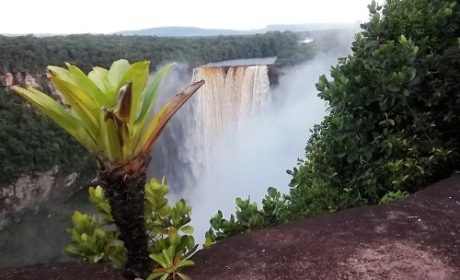Exploring the natural wonders of the world is a great idea for any travel bucket list. There are some seriously amazing sites to be seen on Planet Earth.
Have you been to the awe-inspiring Iguazú Falls, which span the border between Argentina and Brazil? Guest contributor, Kirsten Gallagher, visited the Unesco site with her 67-year-old mother. She’s here with some helpful tips on how to visit Iguazú Falls, the world’s largest waterfall system.
Table of Contents
Iguazú Falls tips for boomer travelers
I don’t know how they did it without killing Jeremy Irons, but there’s a scene in Roland Joffe’s 1986 film “The Mission” in which his character scrambles up some rocks inches away from a gushing waterfall, several stories high.
That waterfall is part of Iguazú Falls National Park, a vast park straddling the border between Argentina and Brazil. It’s home to some of the world’s most impressive waterfalls, including the Devil’s Throat (la Garganta del Diablo).
Recently, I took a trip to Argentina with my mother, who is currently sixty-seven. She really wanted to see Iguazú Falls but was intimidated by the size of the park and the amount of walking that would be required to see it. She thought she would slow me down.
I told her that if we made a careful plan, prioritizing the Devil’s Throat, we could see the falls together at a reasonable pace. If you’re like my mother, in good enough shape to handle nine holes on the golf course, then follow my advice below on navigating the immense Iguazú Falls. You’ll be no worse for wear by the end of the day.
Boomer Travel Tip
MedjetAssist Members who are hospitalized 150 miles from home receive medical transport to a home-country hospital of choice. Memberships from $99.
Getting to the Devil’s Throat at Iguazu Falls

There is no shortage of things to do at Iguazú Falls but what tops everybody’s list is the Devil’s Throat. Get to the park early and make a point to see that first.
There’s a train that picks you up and drops you off at three different stations in the park; the first one you’ll come across is Central Station (Estación Central). Don’t bother waiting for the train here.
It’s much faster to hoof it to the next station, Cataratas Station (Estación Cataratas) by following the Green Trail (el Sendero Verde). It’s only a short distance. Expect to wait in line a while at Cataratas Station, fending off a few peckish coatìs, furry mammals that look a lot like raccoons.
My mother and I rode the train from Cataratas Station to Devil’s Throat Station (Estación Garganta del Diablo) which moved along slightly faster than the average speed walker. Upon arriving, we got in line behind a pokey procession of tourists making their way along the metal walkways leading to the Devil’s Throat.
As we walked, we could hear it: the Iguazú River surging over the Paraná Plateau and descending to the bottom with incredible force. We could also feel it: our clothes were getting soaked from all the water in the air.
On the platform overlooking the immense waterfall, we could barely make out the bottom from all the spray. My mother kept repeating the word “Wow,” over and over again.
Admittedly, it’s hard to be articulate when confronted with the wonder of Devil’s Throat at Iguazú Falls. It forms a wide semi-circle covering 1.7 miles at an approximate height of 269 feet. That scale is hard to appreciate unless you’re there.
Where to eat lunch at Iguazu Falls
Take the train back to Cataratas Station and from there follow the signs for nearby restaurants. There’s a bundle of fast-food joints but fortunately, you’re not limited to eating a slice of pizza or a hotdog like you are in many amusement parks.
The park serves up Argentina’s famous asado, grilled meat, at El Fortìn, a buffet-style restaurant. There’s a surprisingly fresh salad bar, walk-up grill where you can ask for different cuts of meat, and numerous other tasty dishes to fuel you for the rest of the day. With a wide selection, there’s something for everyone.
Walking the Lower and Upper Circuits

The Lower Circuit (Paseo Inferior) and the Upper Circuit (Paseo Superior) are trails that pass by a number of smaller, lesser waterfalls (saltos) that allow you to see the Devil’s Throat from afar. Follow these trails to take more panoramic photos of the Devil’s Throat, which are arguably better than ones taken up close.
Both circuits are less than 1.25 miles each and take less time to do individually than the journey to the Devil’s Throat.
Walking Iguazu Falls Lower Circuit

After filling our bellies, my mother and I headed for the Lower Circuit. She wanted to avoid the stairs so we stayed to the left upon entering the circuit where there was the option to walk down a gentle slope instead. We marveled at the truly beautiful views from the Lower Circuit, not only of the Devil’s Throat, but also of wide, rainbow-filled stretches the park.
The most thrilling part of the Lower Circuit for us was the Bossetti Waterfall (Salto Bossetti). There’s a deck at the bottom of the waterfall and standing there, even for a brief moment, gave us more than a light spritzing—it was like being in the shower!
Exploring Iguazu Falls Upper Circuit
The Upper Circuit as the name implies, is set higher up than the Lower Circuit, and so we could see things from different angles. For example, we could also see the top of the Bossetti Waterfall along the Upper Circuit instead of the bottom.
Perhaps it’s not critical to the experience of Iguazú Falls to do both circuits but neither are particularly strenuous walks. We saw both circuits and the Devil’s Throat and all told, it took us about 6 hours including an un-rushed rest for lunch.
At the end our day at Iguazú Falls, my mother was almost giddy. No doubt she was thrilled by seeing the natural wonder the falls, but I suspect she was also proud for pushing herself a tiny bit out of her comfort zone. I’m certainly glad she did.
Later, Kirsten continued on to a biking tour of Mendoza wine country. Don’t miss her tips!
Save to Pinterest




